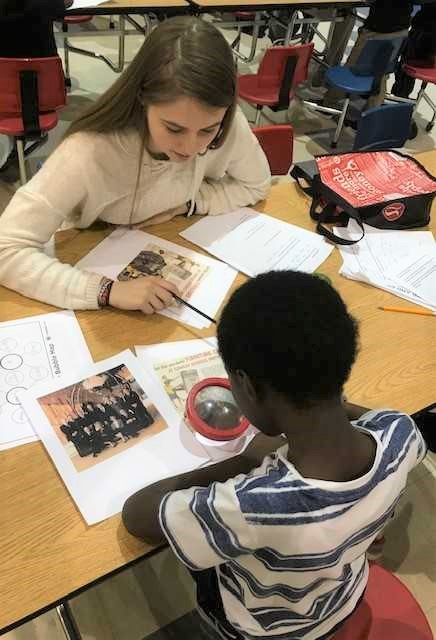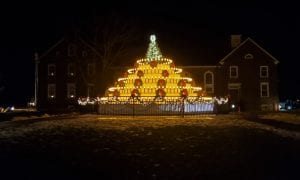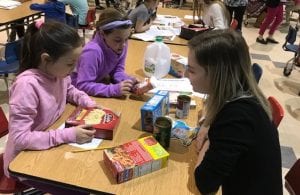
Paper Mill second graders Sophia Jitov and Eva Fallon learn about the Pure Food movement in Westfield from WSU student Emily Slote. (Photo submitted)
WESTFIELD – Paper Mill Elementary School second grade teacher Kathy Knapik and Westfield State University Professor Laurie Risler collaborated this semester on a project for Westfield’s 350 anniversary. Fifty of Prof. Risler’s graduate and undergraduate education students prepared lessons and activities related to Westfield’s long history.
On Wednesday, the college students spent the afternoon teaching their lessons to Paper Mill’s second graders, in an event the younger students are calling “The Westfield 350 History Symposium.“
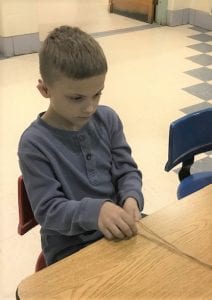
Paper Mill second grader Dylan Woering focuses intently as he tries to weave twine into a whip. (Photo submitted)
Knapik said the second graders love to use big words like “symposium.”
Sixty-five second graders enjoyed learning about historical figures, events, businesses, schools, and landmarks, as well as the contributions of the people who have lived here over the years, from the Native Americans, to the early settlers, to the immigrant groups who came for new opportunities for their families.
Second graders Sophia Jitov and Eva Fallon studied nutritional labels on food packages as part of WSU student Emily Slote’s lesson on the Pure Food Movement. Sophia and Eva learned how in the early 1900’s, Lewis B. Allyn, a professor at the Westfield State Normal School, led the charge to develop federal standards related to food safety.
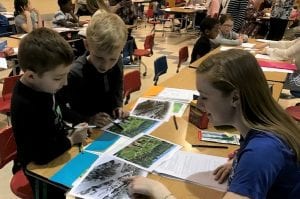
WSU student Stephanie O’Brien guides Isaac Persuitte and Dennis Puznyur in exploring historical maps of Stanley Park. (Photo submitted)
Second grader Dylan Woering learned that in the 1800’s, Westfield was the country’s top manufacturer of buggy whips, which led to the city earning the nickname, The Whip City.
WSU student Stephanie O’Brien guided Paper Mill second graders Isaac Persuitte and Dennis Poznyur in exploring historical maps of Stanley Park. Isaac and Dennis learned how Frank Stanley Beveridge established the park in 1949 and how the park has expanded over the years. Isaac and Dennis then drew their own designs for future developments at Stanley Park.
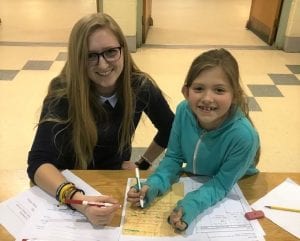
WSU student Madison Shea and Paper Mill second grader Brooke Potenza study historical documents related to General William Shepard. (Photo submitted)
WSU student Madison Shea and Paper Mill second grader Brooke Potenza studied historical documents related to General William Shepard, including a letter written to Shepard by General George Washington. Brooke learned how William Shepard served Westfield as a farmer, a soldier, and a Congressman.
Second graders Ezequiel Vega and Darina Khomich enjoyed a story and a technology presentation on the historic Dewey House, created by WSU student Jordyn Chartier of Westfield, and learned about the life of early settlers in Westfield.
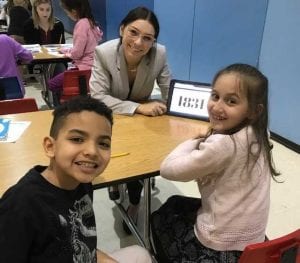
Paper Mill second graders Ezequiel Vega and Darina Khomich enjoy a story and technology presentation by WSU student Jordyn Chartier of Westfield. (Photo submitted)
Second graders Molly Houser and Kamari Richardson used magnifying glasses to examine historical documents related to Stanley Home Products in a lesson by WSU student Katelyn Guilbert of Westfield. Molly and Kamari learned that this company was founded in Westfield in 1931, and employed many salespeople who sold products door-to-door and at home parties.
The second graders and the university students wrapped up their afternoon by writing predictions about what Westfield might be like in 50 years, when it will celebrate its 400th anniversary. The students also made predictions about who they will be in 50 years.
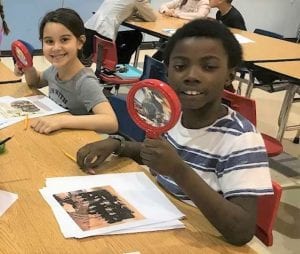
Paper Mill second graders Molly Houser and Kamari Richardson use magnifying glasses to examine historical documents related to Stanley Home Products. (Photo submitted)
In the coming weeks, the second graders will do follow-up projects: creating artifacts and essays related to the topics they studied. Knapik said their projects will be showcased at a Westfield 350 History Fair at Paper Mill in early May, shortly before the city’s official 350 celebrations.
“We will invite our families and our WSU partners to attend,” Knapik said.

